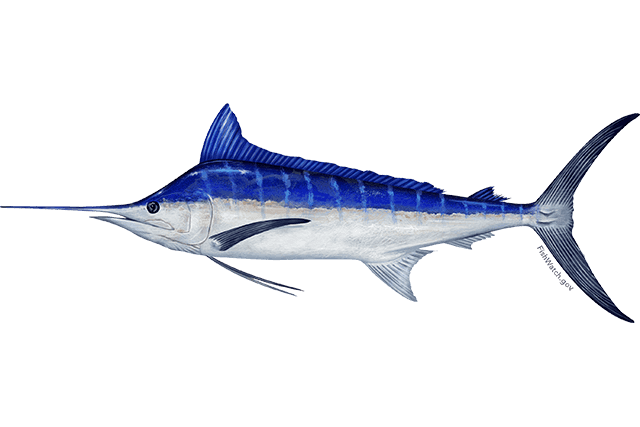Indo-Pacific Blue Marlin

Species Details
Makaira Mazara
Istiophoridae
Perciformes
Offshore
200 - 623 lbs.
132" - 192"
Indo-Pacific Blue Marlin (Makaira Mazara)
The Indo-pacific Blue Marlin with the scientific name of Makaira Mazara is probably one of the most recognizable saltwater gamefish species in the world, not only because of their elongated bodies—that typically has a bluish hue on top and silvery-white bellies, but more so because of their spear-like upper jaws. Although this majestic fish is often mistaken for a black marlin, one (even for an untrained eye) can easily distinguish an Indo-pacific Blue Marlin from its close relative by its highly-elevated nape.
It is also worth mentioning, especially for those fishing for food purposes, that the meat of an Indo-pacific Blue Marlin is highly prized as it’s considered a delicacy in many countries (especially in Japan and South Korea) where they’re eaten raw as sashimi.
Interesting Facts About The Indo-Pacific Blue Marlin
- The Indo-pacific Blue Marlin is one of the fastest fish in the ocean.
- Females are significantly bigger than males.
- They are a highly migratory fish and known to travel thousands of miles as they follow warm currents in the ocean.
- They use their spear-like beaks to inflict serious damage on both their prey and predators—including anglers.
- They are mostly found near the surface but they can also dive deeper to hunt for food, which comprised mainly of tuna, mackerel, and squid.
- Although their average sizes tend to be around eleven feet in length and weighs between two hundred to four hundred pounds, this fish can grow as long as sixteen feet and as heavy as eighteen hundred pounds.
- Significant decline of its population was observed in the Indian Ocean since 1998 because of overfishing—particularly by Japanese commercial fishers when they started long-lining in previous decades.
Indo-Pacific Blue Marlin’s Need for Speed
Thanks to its streamlined body as well as its large tail, the Indo-pacific Blue Marlin is known to be one of the fastest swimmers in the ocean. They are said to average around 50kph to 80kph but can reach a blinding speed of 110kph!
Where to Find Them
The Indo-pacific Blue Marlin can be found throughout the tropical and sub-tropical waters of the Pacific Ocean and Indian Oceans. But as earlier mentioned this fish is highly migratory and that is why they’re pretty well spread in the oceans; as long as the water is warm and there is plenty of food such as tuna and mackerel to prey on, you’ll probably find an Indo-pacific Blue Marlin in it. Also, spawning takes place during summers in Indian and Pacific oceans. So if you’re planning on catching one, there’s a higher probability of success along the west coast during summer.
Indo-Pacific Blue Marlin Fishing Tips
You can use live baits, dead baits, or lures when fishing for an Indo-Pacific Blue Marlin although many anglers prefer skirted surface trolling lures as they’re easier and cleaner to carry. Artificial lures in bright colors would also look like a swimming squid (one of the blue marlin’s favourite diet) when trolling along the water, and this would make it irresistible for blue marlins to take your bait. As for the best trolling speed, you’d get a better chance of catching one 8.5 to 9.5 knots.
Because Indo-pacific Blue Marlins are quite large and known to be powerful and fast swimmers, they will probably put up a tremendous fight. So if you’re lucky enough to hook one, get ready for a battle. Lastly, make sure to watch out for its spear-like beaks when you’re hauling it to your boat as it can potentially be harmful (or even fatal!) if all necessary precautions are not taken. So to protect yourself, your crew, and your boat from damage, just make sure to tire out the fish first while it’s at boat-side by holding the bill just below the surface and moving slowly forward. And even if you think it’s all tired out, you still have to be careful and watch for sudden movements and jerks as the Indo-pacific Blue Marlin can recover quite quickly, especially if it’s not handled properly.






